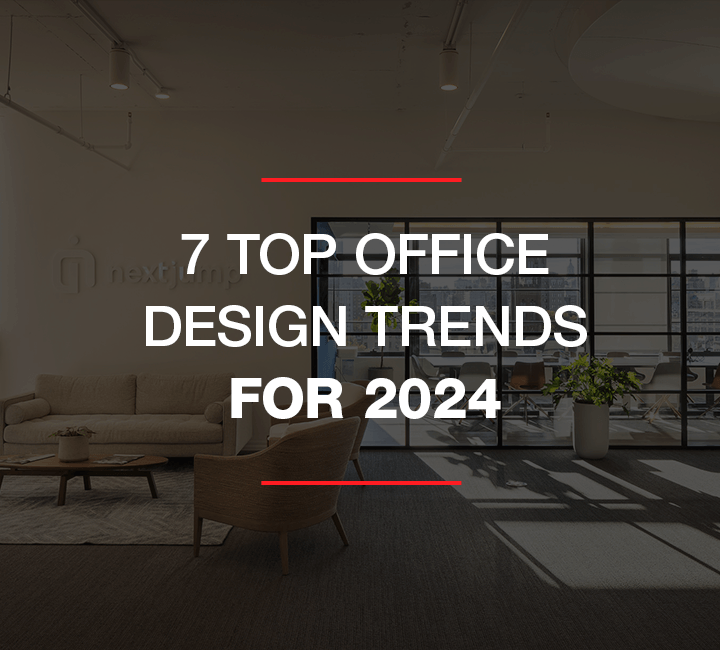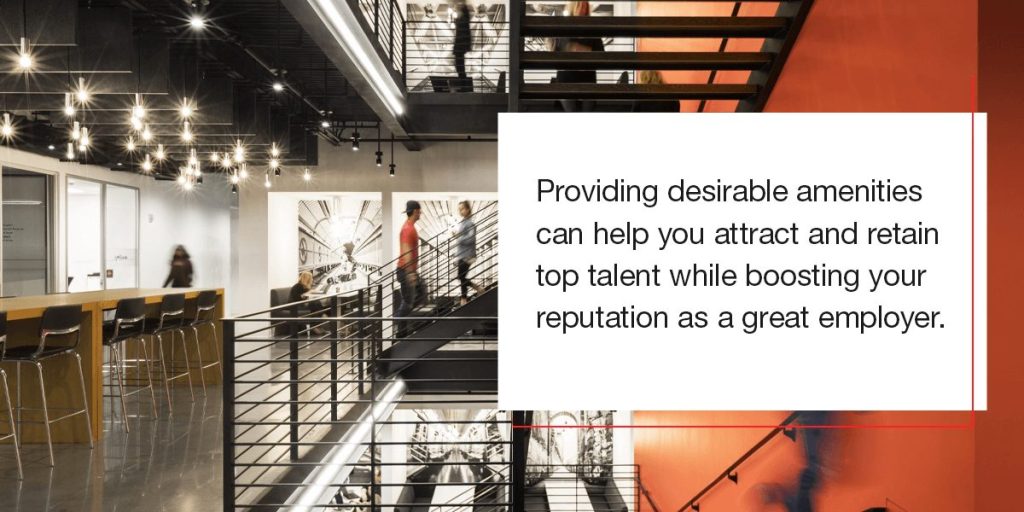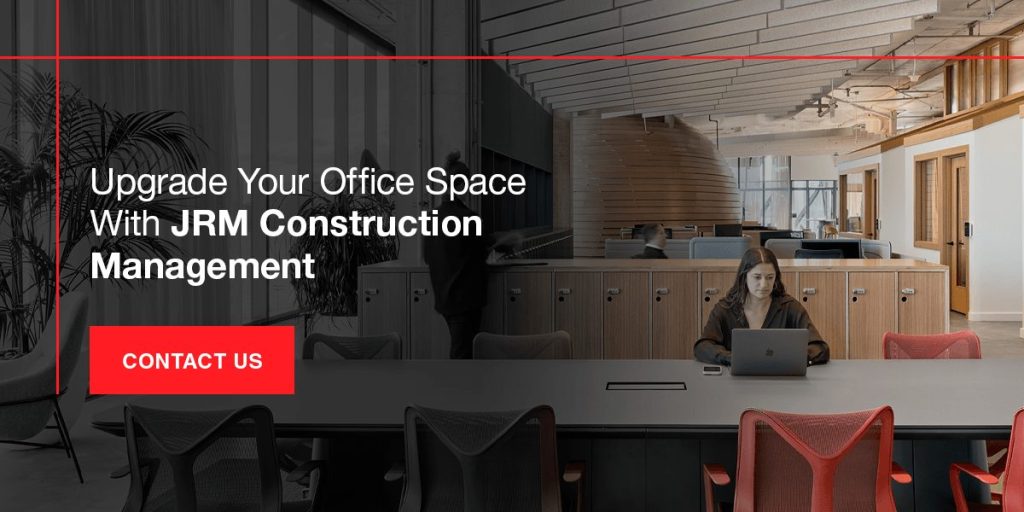7 Top Office Design Trends for 2024

01/17/2024
While the office should be an environment conducive to productivity and employee well-being, the conventional office often discourages people from getting their work done in a way that supports their mental and physical health. Anyone designing a new office building or upgrading their existing space should consider incorporating these office design trends into their plans.
1. Active and Ergonomic Workplaces
Traditional office environments encourage a sedentary lifestyle, which can lead to a wide range of health conditions such as work-related musculoskeletal disorders (WMSDs), hypertension, heart disease, lack of mobility and more.
Ergonomic design includes elements that support the human body and make work more physically comfortable. Adding furnishings that promote physical activity can also help reduce some of the risks of sitting at a desk for too long. Some examples include:
- Office chairs: Traditional ergonomic office chairs support the natural curvature of the human spine, which helps prevent lower back pain. Newer options like balance ball chairs and kneeling chairs provide more active alternatives by encouraging the user to engage their core, strengthening their abdominal muscles.
- Sit/stand desks: Adjustable standing desks let employees limit the amount of time they spend sitting, which can help prevent WMSDs and reduce the risk of health conditions like hypertension, slowed metabolism and heart disease.
- Standing mats: Anti-fatigue mats made from vinyl, PVC or rubber can help encourage employees to get out of their chairs for longer by providing additional support underfoot.
- Treadmill and bike desks: These desks look like cardio machines with attached shelves, encouraging employees to walk or pedal as they work on their computers. You can also pair small treadmills or walking pads with standing desks to save space.
2. Sustainable Design
Environmental protection is increasingly becoming a workplace priority, especially among younger employees. In one study by Cone Communications, 64% of surveyed Millennials said they would refuse a job offer if the employer lacked a strong commitment to advancing social and environmental causes.
Incorporating energy-efficient workplace interior design elements is an excellent way to make your company more sustainable. You can also add more natural elements to help boost morale.
Biophilic Design
Biophilic design is an office interior design concept that has seen a significant rise in popularity in recent years. Because spending time in nature has been proven to decrease stress, incorporating natural elements into your office can help reduce stress and burnout by letting employees connect with nature.
Some examples of biophilic design elements include:
- Water fixtures like fountains or ponds
- Living walls or ceilings
- Flowerboxes
- Large windows for natural light
If your office is located in a big city like New York City or Los Angeles, you could also consider building a rooftop garden for employees to enjoy during breaks or solo work periods.
3. Desirable Office Amenities
It’s one thing to design a beautiful office space, but it’s also important to make your space somewhere people want to work. Providing desirable amenities can help you attract and retain top talent while boosting your reputation as a great employer.
Today’s most popular workplace amenities among Millennials and Gen Z workers include:
- Cafés and snack bars
- Libraries
- Comfortable lounge areas
- Customizable desks and chairs
- On-campus fitness centers
Try to provide amenities that encourage socialization and relaxation for your employees. A coffee bar, for example, is a place employees can gather to chat on their breaks — and enjoy a delicious caffeine boost.
4. Workplace Adaptability
Your office should be able to accommodate different types of work within the same general space. Easily movable desks, private work pods and multipurpose furniture can help you maximize floor space and keep your workforce productive.
Think beyond simple desk hoteling to creating offices where employees can work from multiple places over the course of one workday. For example, an employee might begin their day by getting some solo work done at a hot desk in the corner of the main room, then move to a pod on the other side of the building for a team meeting.
5. Smart Offices
A smart office is an interconnected ecosystem of smart devices, data and furniture that maximizes productivity and comfort. Many smart offices leverage devices connected to the Internet of Things (IoT) to make their space more functional.
Here are some examples of smart office elements:
- Smart desks: Smart desks connect to cloud-based booking platforms, which track open and reserved workspaces. In some cases, they can also track who is working from which desk so teams can reserve spaces near each other for easy collaboration.
- Voice control: Employees can use voice assistants like Apple’s Siri or Amazon’s Alexa to change temperature and lighting settings, search the internet and more. This connectivity promotes greater efficiency and accessibility.
- Intelligent climate and lighting control: IoT sensors in your office can detect temperature and lighting changes and automatically adjust your office’s settings to match, reducing energy costs.
Building a smart office can also help you enhance your company’s reputation by positioning you as a leader in advanced workplace technology.
6. Homelike Atmosphere
The workforce has experienced a wholesale shift to remote and hybrid work — and many remote-capable employees benefit from being at home more often. It makes sense, then, that one of the top office space trends for 2024 is incorporating homey elements into the workplace.
Softening the conventional office with more residential design elements can help you maximize your hybrid and in-person workforce by blending the benefits of working from home with the collaborative element of being in the office. Some examples of elements you can use include:
- Textures: Choose furniture with a variety of different textures to mimic a typical living space. Some potential ideas include wicker chairs, wooden floors, plush couches and patterned rugs.
- Surfaces: Mixing different surfaces together creates a unique look reminiscent of a kitchen or living room. Wood furniture, exposed brick and carpet are popular choices.
- Color: People respond differently to different colors. Neutral and earth-toned color palettes are relaxing and homey, so finding ways to use those colors can help you create a calm atmosphere.
When your office feels like a welcoming place, employees can relax and engage more fully with their work — which translates to increased productivity and revenue generation.
7. Brand Promotion
A branded office design creates a cohesive experience and inspires loyalty from employees. One easy way to promote your brand through your office is to start with your brand colors and visual elements and build out your design from there.
For example, if your brand name uses a rounded font, you could choose furniture with rounded edges and use the font on all your signage. You could also pick decorations — such as desk lamps, flower pots or accent walls — in your brand colors. The combination of these elements helps tie everything together, producing an aesthetic visual experience.
Upgrade Your Office Space With JRM Construction Management
Workplace interior design benefits everyone at a company. Whether you’re redesigning your office or creating a coworking space for remote workers and freelancers, the experts at JRM can help you build your vision.
We’ve delivered beautiful and highly functional office spaces to a diverse range of clients across the country, from New York City to California. Browse our past projects to see examples of how we can help you design an amazing office space, or contact us online for more information about our services.




)